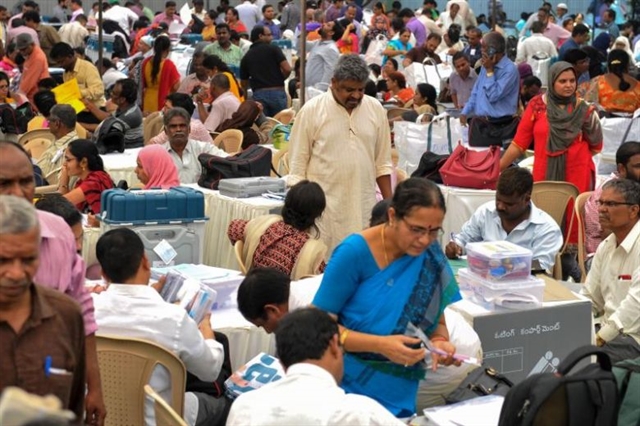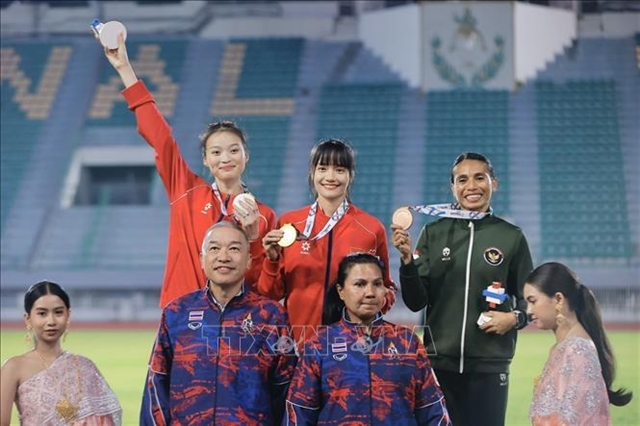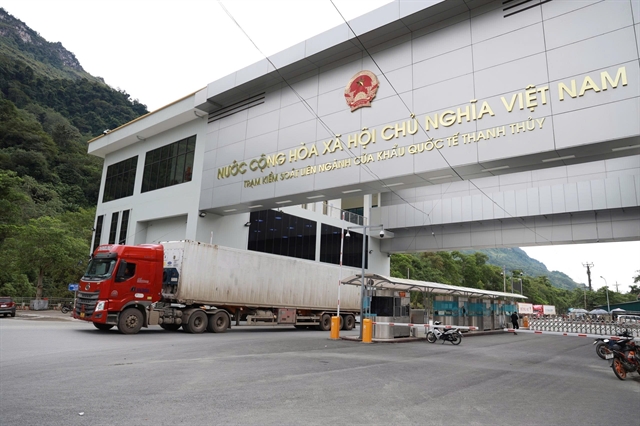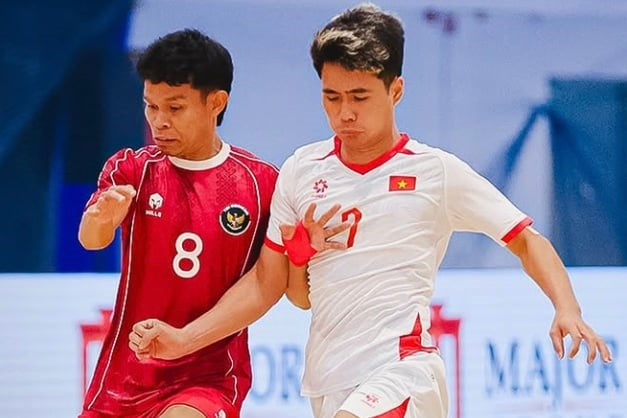 World
World

The Indian Prime Minister is up for re-election and as of now the frontrunner to retain power. But he is also arguably the most polarising – and powerful -- political leader in India since the Late Indira Gandhi.

|
| Indian election officials check polling material and Electronic Voting Machines at a distribution centre in Hyderabad on April 10, 2019.—AFP Photo |
Narendra Modi
The Indian Prime Minister is up for re-election and as of now the frontrunner to retain power.
But he is also arguably the most polarising – and powerful -- political leader in India since the Late Indira Gandhi.
Having led the BJP to a massive 283 seats on its own (well over 300 with allies) in the 2014 elections – the first time a single party won a majority on its own in 30 years -- Modi, 68, has spent the past five years leaving his imprimatur on the Indian body politic.
For his admirers and supporters, or bhakts (devotees) as they are known, he has been just what the doctor ordered.
A muscular approach towards dealing with Islamist terror emanating from Pakistan, an integrationist approach towards the conflict-hit state of Jammu & Kashmir and providing a corruption-free administration are his primary calling cards for 2019.
Aided and abetted, of course, by Modi’s unambiguous expression of a robust nationalism that derives inspiration from the Bharatiya Janata Party’s emphasis on the country’s Indic/Hindu civilizational/cultural heritage.
On the economy, he is lauded by his supporters for striking that fine balance between growth-oriented policies aimed at ‘growing the pie’ and the welfarist agenda no government in India can afford to ignore given that over 200 million rural and urban poor call India home.
Modi, who comes from a very modest family background and has famously sold tea at railway stations while growing up in poverty in his native state of Gujarat, was the proverbial outsider to New Delhi’s corridors of power in 2014.
Though he had been Chief Minister of Gujarat for three terms and had his share of admirers, he was not considered a heavy hitter in national politics.
He was not even counted among the top rung of BJP leaders till he was declared the party’s candidate for PM in 2013, after it had suffered two consecutive defeats in the general elections of 2004 and 2009.
Today, those days are long gone.
He launches his 2019 re-election bid not only on his record as the head of government for five years but also after having successfully taken complete control of the BJP organisation, which is now in the hands of his oldest political confidant Amit Shah as party president.
Together, they have more or less completely marginalised the academic, media, bureaucratic, cultural and civil society influencers who held sway over the public narrative under all earlier regimes including the Congress’.
Those simpatico to the Nehruvian idea of India, as it were, have been unceremoniously supplanted by those owing ideological affinity to the Rashtriya Swayamsevak Sangh, the BJP’s ideological parent which promotes a sense of ‘inclusive’ Indic/Hindu nationalism in public life.
Personal loyalty to the Modi-Shah power couple is, of course, also very much part of the territory.
A virtual purge of the BJP has also been completed with a galaxy of senior leaders including Modi’s own mentor and former Deputy Prime Minister LK Advani having been pushed into retirement from electoral politics while others have quit the party, humiliated.
Modi is running a presidential-style campaign. The focus is firmly on himself.
He is the common man from the boondocks who rose through the ranks thanks to his hard work.
A vivid contrast, goes the pitch, to an entitled scion of the Nehru-Gandhi political dynasty, Rahul Gandhi, who ‘inherited the crown’ of Congress Party president from his mother Sonia Gandhi.
The BJP campaign plays on Modi’s perceived incorruptibility, the sense that his intentions are honest even if some of his decisions, especially those on the economy, have not been on-target, and his nation-first approach.
Modi, clearly, has emerged as the primus inter pares of Indian politics.
It is precisely for that reason that his opponents have, in a sense, ganged up on him and worked out a network of state-level alliances in an effort to stop him and his allies from hitting the majority-mark.
The 2019 election, however, remains Narendra Modi’s to lose.
Rahul Gandhi
The national election campaign against Prime Minister Narendra Modi is led by the Congress, India’s oldest albeit much shrunken political party.
At the head of it, stands the 48-year-old, soft-spoken judoka and once-upon-a-time reluctant politician, party president Rahul Gandhi.
Rahul, as he prefers to be addressed, is the inheritor of a formidable political legacy. His father Rajiv Gandhi, grandmother Indira Gandhi and great-grandfather Jawaharlal Nehru have all been Prime Ministers.
But times have changed.
He is fighting an uphill battle to ensure that the Congress betters its measly tally of 44 seats in the 2014 election.
Simultaneously, he needs to coordinate his campaign with other Opposition leaders in the hope of cobbling together a post-poll coalition to prevent Modi’s return to power if the BJP falls even marginally short.
Rahul is talking up the lack of jobs under the Modi Administration, inequitable growth that favours crony capitalists and an atmosphere of impunity which has normalised anti-minority, especially anti-Muslim sentiment.
Criticised in the past as too soft for the hurly-burly of Indian politics, Rahul has minced no words in criticising the personality cult around the Prime Minister.
Especially, its projection by ‘misusing’ the media and Modi’s ‘arrogant’, know-it-all attitude.
But the truth is that educated in India and the US, Rahul has never really been a professional with a life story to tell. He was drafted into the Congress by his mother in the early years of the new millennium when he was just in his 30s.
His intervention on behalf of a gentler India, therefore, where the poorest are taken care of and minorities protected, have struck a chord.
He was first off-the-block to focus on the poor and his minimum income guarantee scheme that will cover the poorest 20 per cent of India’s nearly 1.3 billion people has been well received.
But in an aspirational India where hand-out socialism is passé and over 400 million of India’s eligible voters are in the 18-28 age group, the jury is still out on what the electoral dividends for him will be.
It may have also come a bit late in the day.
Rahul’s appeal to the youth looking for jobs, farmers, especially landless labourers and share croppers, and minority communities has undoubtedly also generated some support.
Given the shambolic condition of the Congress party organisation where activists are missing on the ground, however, converting support for Rahul’s narrative into votes in a substantive way will be difficult, admit party insiders.
A tactical mistake isn’t helping his cause either.
In his effort to project the Congress as a pan-India party, Rahul will be contesting from two seats; his traditional constituency in the North Indian state of Uttar Pradesh and another in Kerala, in the deep South of the country, where the Muslim-Christian population happens to be in a majority.
The BJP has pounced on his “running away” from his traditional seat claiming he fears a humiliating loss.
On top of that, Rahul is having to push back hard, especially on social media, that contesting from a Kerala constituency where Hindus are a minority is not an indication of his party ignoring Hindu sentiment while appeasing minorities.
Rahul, of late conscious as a politician of his mixed heritage given his mother’s Italian origins, has made a concerted effort at asserting that he is a practising Hindu. In fact, he has taken to publicly describing himself as a Shiv Bhakt (Devotee of Lord Shiva) and has been on a temple-visiting spree.
His induction of his younger sister Priyanka Gandhi Vadra as a senior functionary of the Congress a couple of months ago has only furthered the impression of a politician under siege, weighed down by expectations, who needs the support of those closest to him.
When it comes to hard numbers, the best-case scenario for Congress in most estimates including credible opinion polls is of wining between 80-100 seats with another 30-40 for its allies.
That seems about right and may just be enough for Rahul to live to fight another day.
Mayawati
A conglomeration of powerful, regional satraps who head parties looking to maximise the seats they can pick up in their respective states of influence and known collectively as the Third Front has emerged as the crucial player in Election 2019.
One of its leading lights is Mayawati (she goes by only one name).
The undisputed leader of a large section of the Dalit or scheduled caste community, to which she herself belongs, Mayawati, 63, is perhaps the most powerful leader in the state of Uttar Pradesh (UP) which accounts for as many as 80 MPs in a House of 543.
She was a school teacher in an impoverished Delhi suburb who was mentored for a leadership role by the late Kanshi Ram, founder of the party she now heads, the Bahujan Samaj Party or BSP. It translates roughly as party of the (disempowered) majority.
She was instrumental in mobilising this social group which had been empowered by India’s post-Independence affirmative action policies including quotas in education and public sector jobs but was politically under-represented.
Over the past three decades, she consolidated her Dalit support base and began an outreach to other castes and communities including those who had historically repressed scheduled castes, especially in UP.
As a result, she was thrice the Chief Minister of Uttar Pradesh and even her opponents conceded that she was tough on crime in a state notorious for its pathetic law and order situation.
Over the years, however, she has been accused of massive corruption and a case relating to her accumulation of assets disproportionate to her known sources of income is ongoing.
The BJP, which made serious inroads into the Dalit vote-bank in UP where it won 73 seats in 2014, is thought to have turned the screws on her under the Modi regime and let investigative agencies get on with their job.
The BJP government has also been accused by its opponents of a reactionary, ‘upper caste’ mentality which is against Dalits despite Modi’s vigorous denial of such charges.
As a result, Mayawati – who has in the past has supped politically both with the Congress and the BJP – is leading a formidable Opposition ‘grand alliance’ against Modi jointly with another former Chief Minister of Uttar Pradesh, Akhilesh Yadav of the Samajwadi (or Socialist Party).
Purely on electoral arithmetic and tabulating past vote-share of the major parties in Uttar Pradesh (including the BJP sweep of 2014), the Grand Alliance led by Mayawati is in pole position.
If the alliance partners can ensure a transfer of votes to each other, the BJP will be in big trouble and Modi may find himself losing at least 40 seats in Uttar Pradesh, which could be the kiss of death for his prime ministerial ambitions.
In the bargain, Mayawati’s chances of taking a shot at becoming Prime Minister with support from other parties including the Congress if her alliance gets more than 50 seats will only improve.
Mamata Banerjee
Mamata Banerjee is the stormy petrel of the anti-BJP, non-Congress Opposition.
As the Chief Minister of West Bengal, she rules the state with an iron grip from Kolkata (earlier Calcutta) known as the cultural capital of India.
More crucially, it is a state that sends 42 MPs to Parliament.
Banerjee is one of the most vociferous critics of Prime Minister Narendra Modi and a prime mover of the Third Front that seeks to dislodge him from power ‘at any cost’ to ‘save democracy’.
And she is bringing all her experience in agitprop and ability to sustain a political campaign to bear against Modi.
An erstwhile front-ranking Congress leader from the state promoted over senior leaders by the Late Rajiv Gandhi, she broke ranks with the Grand Old Party in the late 1990s.
Reason: She accused it of not being serious about fighting the Communist alliance which ruled West Bengal from 1977 till 2011.
Banerjee, 64 and unmarried, founded a regional party the Trinamul (or Grassroots) Congress Party, TMC, in 1998 and is known as Didi (elder sister) by her supporters and opponents alike including in the national media.
A fighter who gave the Communist cadre as good as she got, she was admired even by her opponents for her courage in the face of intimidation and physical assaults by Left goons during protests she led.
Her spartan lifestyle – she still wears a modest, hand-spun sari and her trademark flip-flops – also endeared her to vast sections of the population.
After a decade of political struggle against the Communists as the head of the TMC, Banerjee finally won the state election in 2011 and was sworn-in as Chief Minister.
She then proceeded to out-Marx the Marxists.
Social security schemes, promotion of the public sector, strong trade unions, hand-outs for the rural poor and urban underclass, sops for religious minorities – West Bengal has a large Muslim population of approximately 30 per cent – all formed part of her policy bouquet.
She won again with an even bigger majority in the 2016 state polls.
Her party successfully resisted the Modi-wave in the 2014 general election and won 34 Lok Sabha seats out of 42 in West Bengal making the TMC one of the largest Opposition parties in Parliament.
But the BJP has since 2016 emerged as the principal opposition to her in the state as the Communist and Congress party organisations have withered and their cadre has been mopped up by the TMC.
BJP president Amit Shah has focussed resources and lavished attention on the state with a view to taking the BJP tally in the 2019 general election from “two to 22”.
A combination of defections from the TMC, building the party organisation and mobilising Hindus against Banerjee’s perceived bias against the majority community, is part of the BJP strategy to breach Bengal.
Corruption charges against party leaders relating to a ponzi scam in which millions lost money have taken the sheen off Banerjee’s spartan image too.
The Prime Minister himself is addressing a series of election meetings in the state and is hammering home Banerjee’s allegedly “soft” approach to illegal immigration by Bangladeshi Muslims for “vote-bank politics”.
Banerjee, though, as she has shown more than once in her political career, is no pushover.
She is hitting back hard, mocking the Prime Minister for his rhetorical flourishes that amount to zilch (jumlaas).
The loudest applause at Banerjee’s political rallies is when she accuses the BJP of playing community against community, Indian against Indian.
Relentless in her criticism of the Modi regime’s ‘economic mismanagement’, Mamata Banerjee is also aware that if she loses ground in the 2019 general election, the state elections due for 2021 will be very tough for her.
She is, in that sense, fighting for her political survival. — Asia News Network
DEMOCRACY, INDIA-STYLE
|




